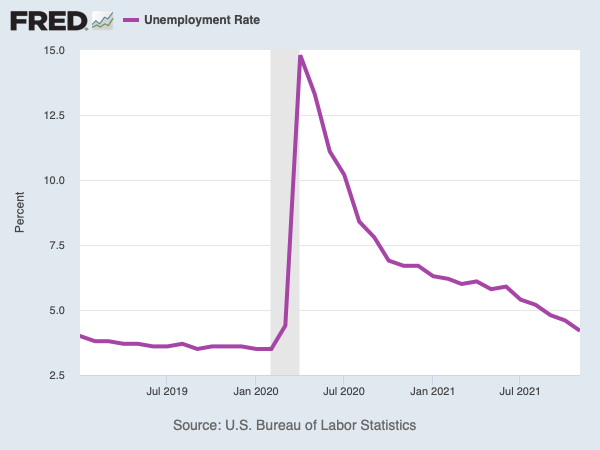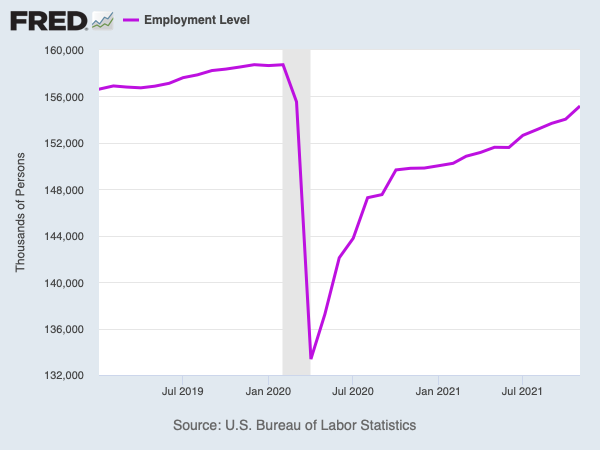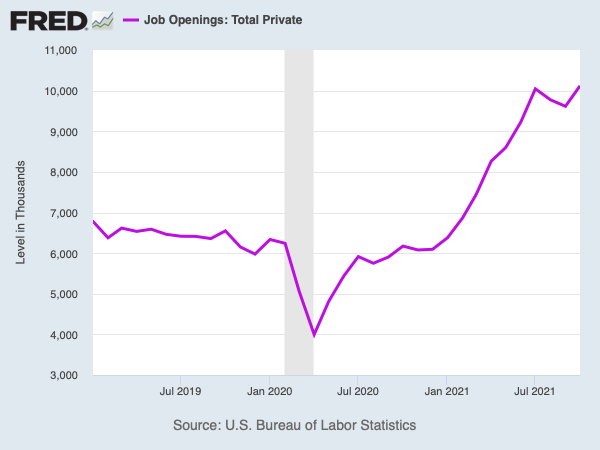

Discover more from American Ambition
We are almost back to the hottest employment market of our lives.
January 2020 was the high water mark for the boom. The pace we were on immediately before the pandemic was astounding. It was already the best time ever to be an employee, and the situation just kept getting better and better.
Today, the job market is very, very good.
Unemployment is very low. Not quite as amazing as January 2020, but very low, and getting lower each month. If you’re looking for work, it is a terrific time to be in the job market. (We’ll write a professional resume for you for free and apply to jobs for you if you are looking for a new job.)
Pay is going up. There are more jobs open than people looking, which means bosses have to offer more money to attract professionals like you. Companies are doing very well, so they can afford more pay, which means that the employment party is likely to continue for some time. 🤞🤞
If there’s a gray lining to this silver cloud, it’s the number of people working, or rather, not working. The total number of people in the United States who currently have a job is down a bit compared to January 2020.
The number of people working and the number looking for work combined make up the labor force. That includes everybody who is available to work in America. It excludes retired people, stay-at-home parents, and any other adult not looking for work at all.
The problem is that our labor force is a little bit smaller than it was pre-pandemic, while the population has kept growing. It’s a small percentage difference but it’s enough to cause us problems - missing staff at your local restaurant, critical shortages in our trucking and shipping systems, a cascading series of dominos falling over when factories don’t have enough workers to produce materials for the next factory.
If we get these small problems under control in 2022, and we can get more people back in the labor force, we could have another seven years of plenty ahead of us. That’s good for your bank account and that’s good for the country.
The numbers:
From a numbers point of view, the unemployment rate has been on a journey from a pre-pandemic low of 3.5 percent, which is considered better than “full employment” by the economics profession, to its worst month in April 2020 — 14.8 percent. Since then, we’ve seen steady improvement, to the point that the unemployment rate for November was just 4.2 percent. Which is excellent.
The total number of employed people is a bit concerning. From 159 million before the pandemic to 155 million today. That might seem like a small, maybe insignificant, drop compared to what happened in between.
But during that time period, the US population has grown from 328 mm to 332 mm. And we should have seen two million of that increase show up in the workforce.
So we have 6 million fewer people in the labor force than we’d expect, which is 4% of the total. And when we’re dealing with employment, four percent is actually a pretty big number. A four percent difference changes the way your town, your family, and your co-workers experience the economy. It means that in your friends-of-friends group, you’ll probably know dozens of cases where people are not working as much as they want to, or used to, work.
Which is one of the reasons the job openings number is up so much. Running over 6 million before the pandemic, the number of open jobs for which employers are hiring took a nosedive to just 4 million in April 2020. Today, the number of open jobs is greater than 10 million for the first time in US history.
If we can get more citizens back in the workforce, and available for work, we could see a boom for many, many years ahead, and that silver cloud will be raining dollars on our heads instead.
How I report the data to you:
There’s a lot of economic data available, and I try to focus on what’s most relevant for you. There are two different methods the U.S. Bureau of Labor Statistics uses to inform us about the jobs picture.
What you’ll hear on the news is often focused on the Establishment data. This data comes from a monthly survey of 144,000 businesses. It reports hiring, pay, and hours from the point of view of the employer. Economists and investors tend to prefer to discuss these numbers, because they’re thinking about the economy and the stock market first.
I’m a jobs guy, and think about unemployment and the economy from the point of view of you, the American professional. As a result, you’ll usually find me focusing on the Household data first. Household data comes from a monthly sample survey of 60,000 households and measures employment and unemployment by looking at the real people involved. In my view, it gives a better picture of what you, as a citizen, are experiencing in the economy today.
The two are supposed to match up, and over time they do, so there’s no sense in overstating the differences. But if you’re wondering why sometimes my assessment of job numbers vary from what you’ll read in the Wall Street Journal or hear on CNBC, it’s because I look at the people numbers first, business numbers second, and they do the opposite.
Thanks for reading!
Let’s grow!
Marc Cenedella
Follow me on twitter: @cenedella
Subscribe to American Ambition
“An informed patriotism is what we want. Are we doing a good enough job teaching our children what America is and what she represents in the long history of the world? She is a shining city upon a hill.” - Ronald Reagan ~Largest Substack on the Right~














Interesting. Regarding the large number of unfilled jobs ... I saw somewhere else (and I can't find it now, it must be lost in my infinite news feed somewhere) that contributing to this trend are older workers (most likely Boomers) who are retiring sooner or taking "early retirement packages" in larger numbers than expected. Population-wise, they make up a huge chunk of the population and I wonder if you think that could be part of what's happening.
The other thing that may be contributing to the number of open jobs is that workers may have cut back on extra jobs ... as in gone from 3 jobs to 2 or from 2 jobs to 1 with the pandemic. I have no source for that either, but I did hear it mentioned once by an analyst on one of the news shows.
Marc,
I'm sure that you are getting some current data on the jobs being filled and hiring is doing well. Which is exactly what the government wants us to think. I do not believe any of that from where I stand and what I am seeing first hand. they say unemployment is down, of course it is because when you run out of benefits your no longer in the count so that changes the number.
I have companies telling me thy cant man the job because there are no workers. they cant stay open later then normal because no workers. Some close friends have closed their business and others are working double shifts just stay open.
My very close friend has gone on 5 interviews 3 of them were leads that I gave to contacts of mine that I know well and I was told they didn't get a call back. I reached out and they said we don't have the people to hire actually and a few other things. If a spot is available we will call. Now for one that makes me look like shit when they asked if I had anyone looking and they had the resume in the next 15 mins. of the person I sent and now nothing. So the person who put trust and faith in me that I said i could help has lost that.
The only people that are working are the ones that worked all through Covid - 19 with no extra pay or compensation or free government money. The one's that are not for the most part are the ones sucking off the government's tit. yes lets sit at home and collect free money that will cost the next 2 or 3 generations issue. maybe the government should just STFU and stay in DC and Off the tv. they are not helping one bit.
So help me out here please
Sincerely,
Anthony R (Moose) Ticconi